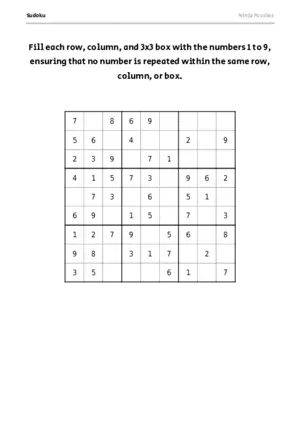Sudoku: Hidden Pairs and Triples Strategy and Techniques
The Hidden Pairs and Triples strategy is an advanced technique in Sudoku puzzle solving. It involves identifying two or three candidate numbers that only appear in the same two or three squares within a unit (row, column, or box). By recognizing these hidden patterns, you can eliminate those candidate numbers as possibilities from other squares within the same unit.
Here’s how the Hidden Pairs and Triples strategy works:
- Analyze the Unit: Select a specific unit, such as a row, column, or box, that you want to focus on.
- Identify Candidate Numbers: Examine each square within the chosen unit and determine the candidate numbers for each empty square. Candidates are the possible numbers that could fill a particular square.
- Look for Hidden Pairs or Triples: Search for two or three candidate numbers that only appear in the same two or three squares within the unit. These numbers should have no other candidates within the unit.
- Eliminate Candidates: Once you identify the Hidden Pairs or Triples, you can eliminate the other candidates from the squares that contain those hidden pairs or triples. This is because those squares must contain the identified numbers, and thus other candidates cannot be present in those squares.
- Update the Puzzle: After eliminating the candidates, reassess the puzzle and repeat the process for other units, looking for additional Hidden Pairs or Triples that can lead to further eliminations.
By using this strategy, you can discover connections between candidate numbers that are not obvious at first glance. This technique helps narrow down possibilities within a group and provides helpful hints for solving puzzles.
It’s worth noting that Hidden Pairs and Triples can be more challenging to identify compared to Naked Pairs and Triples because they are not immediately visible. You need to examine an entire group to find these hidden relationships. However, with practice and experience, you’ll become skilled at quickly spotting hidden patterns and using them effectively to solve even the most difficult Sudoku puzzles.
Remember, combining the Hidden Pairs and Triples strategy with other techniques will enhance your overall puzzle-solving skills. With practice, you’ll gain a deeper understanding of the puzzle’s structure and speed up your solving progress.
Sudoku Solver
If you get really stuck then we have an online Sudoku Solver, and a Sudoku Mini Solver to help you solve the most challenging Sudoku puzzles.
Advanced Sudoku Strategies
- Singleton Technique: This strategy involves identifying squares that have only one possible candidate number based on the numbers already present in the row, column, and box.
- Naked Pairs and Triples: When two or three squares in a unit (row, column, or box) have the same two or three candidate numbers, those numbers can be eliminated as possibilities from other squares in the unit.
- Hidden Pairs and Triples: This strategy focuses on identifying two or three candidate numbers that only appear in the same two or three squares within a unit. These numbers can then be eliminated as possibilities from other squares in the unit.
- Sudoku X-Wing: Sudoku X-Wing involves finding two rows or two columns where the same number can only occur in the same two positions. By eliminating that number as a possibility in the corresponding rows or columns, you can make further deductions.
- Swordfish: Similar to Sudoku X-Wing, Swordfish strategy expands the concept to three rows or three columns. It involves finding three rows or three columns where the same number can only occur in the same three positions, allowing for further eliminations.
- Sudoku Y-Wing: Sudoku Y-Wing is an advanced strategy that involves three cells and three numbers. By utilizing a specific pattern of candidate numbers, you can make deductions that lead to solving other squares.
- Sudoku XYZ-Wing: XYZ-Wing involves three cells and three numbers, with each number belonging to a different candidate list. It allows for deductions by creating chains of eliminations based on the relationships between the three numbers.
- Coloring: This strategy involves assigning colors (usually two) to candidates and using the relationships between these colors to make deductions.
- Backtracking: Backtracking is a brute-force technique that involves making educated guesses and trying different possibilities until a contradiction is reached or the puzzle is solved.








